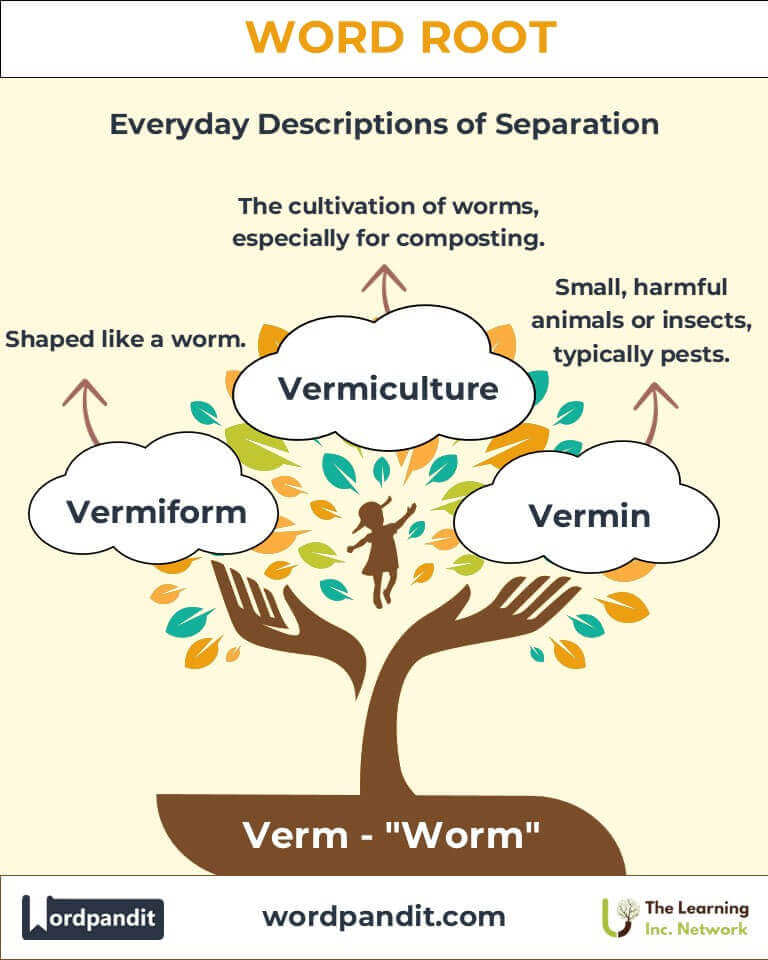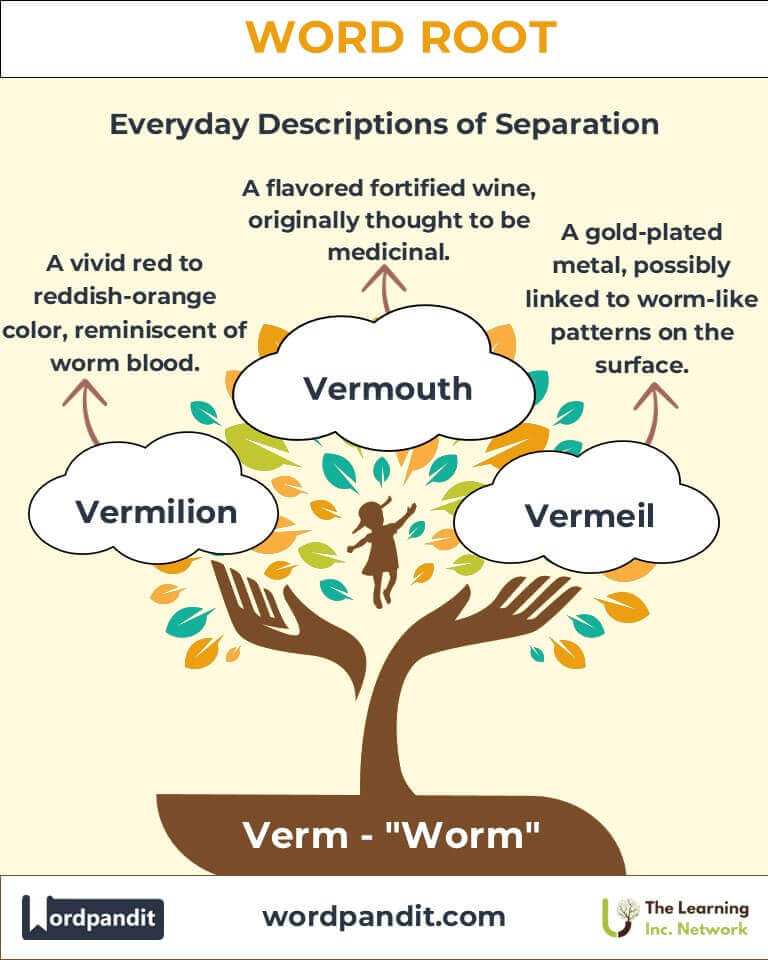Verm: The Worm Root in Language and Life
Byline:
Discover the linguistic richness of the root "Verm", derived from the Latin word meaning "worm." From biological references like "vermiform" to culinary delights like "vermicelli," this root threads its way through language, science, and culture, symbolizing forms, movement, and texture.

Table of Contents
- Introduction: The Essence of Verm
- Etymology and Historical Journey
- Mnemonic: Unlocking the Power of Verm
- Common Verm-Related Terms
- Verm Through Time
- Verm in Specialized Fields
- Illustrative Story: Verm in Action
- Cultural Significance of the Verm Root
- The Verm Family Tree
- FAQs about the Verm Word Root
- Test Your Knowledge: Verm Word Root Quiz
- Conclusion: The Living Legacy of Verm
1. Introduction: The Essence of Verm
What do wriggling worms, intricate pasta shapes, and biological structures have in common? The answer lies in the root "Verm", derived from Latin, meaning "worm." Pronounced "vurhm," this root vividly captures forms, textures, and movements reminiscent of worms. Whether in scientific descriptions or culinary creations, "Verm" reflects a unique blend of natural inspiration and cultural expression.

2. Etymology and Historical Journey
The root "Verm" originates from the Latin word vermis, meaning "worm." Over time, its influence spread across languages, finding a place in Old French and Middle English. By the Renaissance, "Verm" enriched scientific, artistic, and culinary vocabularies, embodying wriggling motion, tubular forms, and textures. For instance, medieval texts often used "vermiform" to describe worm-like shapes in anatomy and zoology.
3. Mnemonic: Unlocking the Power of Verm
To remember "Verm," picture a bowl of vermicelli pasta, its slender, wriggly strands resembling tiny worms.
Mnemonic Device: "Verm weaves its way like worms through the heart of language."
4. Common Verm-Related Terms
- Vermiform (vurh-mi-form): Worm-shaped.
- Example: "The vermiform appendix gets its name from its worm-like structure."
- Vermicelli (vurh-muh-chel-ee): A type of pasta resembling thin, worm-like strands.
- Example: "Vermicelli is a staple in both Italian and Asian cuisines."
- Vermiculture (vurh-mi-kul-cher): The cultivation of worms for composting.
- Example: "Vermiculture transforms organic waste into nutrient-rich fertilizer."
- Vermin (vurh-min): Harmful or undesirable pests, often likened to worms.
- Example: "The granary was overrun by vermin, endangering the stored crops."
- Vermifuge (vurh-mi-fyooj): A substance used to expel worms from the body.
- Example: "Doctors in ancient times prescribed herbal vermifuges to treat infections."
5. Verm Through Time
- Vermiform (16th Century): Originally used in anatomical texts, describing worm-like structures in humans and animals.
- Vermicelli (17th Century): Named for its resemblance to worms, this pasta became a culinary favorite worldwide.
6. Verm in Specialized Fields
- Medicine:
- Vermiform Appendix: A small, worm-like structure in the human digestive system, significant in anatomical studies.
- Vermifuge: Medications to treat parasitic worm infections.
- Agriculture:
- Vermiculture: A sustainable practice using worms for organic waste management.
- Culinary Arts:
- Vermicelli: Widely used in dishes ranging from soups to desserts.
7. Illustrative Story: Verm in Action
Dr. Elena, a biologist specializing in vermiculture, was on a mission to transform urban waste management. She introduced vermiculture in community gardens, where worms processed organic waste into rich compost. Meanwhile, at a nearby café, a chef prepared a signature dish featuring vermicelli pasta, its delicate texture delighting diners. The intertwined stories of Dr. Elena and the chef highlight how "Verm" connects science and everyday life.
8. Cultural Significance of the Verm Root
The root "Verm" symbolizes transformation and adaptability. Worms, often underappreciated, play a vital role in ecosystems, recycling nutrients. In language and culture, "Verm" celebrates their motion and forms, inspiring culinary, agricultural, and scientific advancements.

9. The Verm Family Tree
- Verm (Latin: worm):
- Examples: Vermiform, vermiculture.
- Helminth (Greek: parasitic worm):
- Examples: Helminthology (study of worms).
- Scolec (Greek: worm):
- Examples: Scolecophidia (a group of worm-like snakes).

10. FAQs About " Verm "
Q: What does "Verm" mean?
A: "Verm" comes from the Latin word vermis, meaning "worm." It refers to worm-like forms or textures and is used in various fields such as biology, medicine, and even cooking, where it symbolizes thin, elongated shapes resembling worms.
Q: Why is vermicelli named after worms?
A: The name "vermicelli" literally means "little worms" in Italian. The pasta strands resemble the thin, wriggly shape of worms, which inspired its name. Despite the reference to worms, vermicelli is widely enjoyed in cuisines worldwide, known for its delicate texture.
Q: What is the vermiform appendix, and why is it called that?
A: The vermiform appendix is a small, tubular structure attached to the large intestine in the human body. Its name comes from its worm-like shape (vermiform meaning "worm-shaped"). While once thought to have no function, it is now believed to play a role in gut immunity.
Q: What is vermiculture, and why is it important?
A: Vermiculture is the cultivation of worms, typically for composting organic waste. The worms break down waste into nutrient-rich compost, which improves soil health and reduces landfill use. This sustainable practice supports agriculture and eco-friendly waste management.
Q: Are vermifuges still relevant in modern medicine?
A: Yes, vermifuges, substances that expel parasitic worms from the body, remain important in treating infections like roundworm or tapeworm infestations. Modern vermifuges are more effective and safer than historical herbal remedies, addressing a global health concern, especially in areas with poor sanitation.
Q: What is the cultural significance of worms, as seen in "verm"-related terms?
A: Worms have often symbolized rebirth, transformation, or decay in various cultures. In practical contexts, they represent utility (e.g., vermiculture) and adaptability. The word root "verm" reflects their influence on language and science, celebrating their crucial ecological role.
Q: How does "vermiform" connect to other scientific terms?
A: The term "vermiform" is frequently used in anatomy and zoology to describe worm-like shapes, such as the vermiform appendix or the body shape of certain organisms. It highlights how natural forms inspire scientific descriptions.
11. Test Your Knowledge: " Verm " Mastery Quiz
1. What does "Verm" mean?
2. Why is the vermiform appendix called "vermiform"?
3. What is vermiculture primarily used for?
4. Which of the following best describes vermicelli?
5. What is a vermifuge?
12. Conclusion: The Living Legacy of Verm
The root "Verm" underscores the humble worm's enduring influence across disciplines. From vermiform structures in anatomy to the culinary delight of vermicelli, this root inspires curiosity and appreciation for the natural world's intricate designs. As science and culture evolve, "Verm" will continue to wriggle its way into new realms of innovation and expression.












